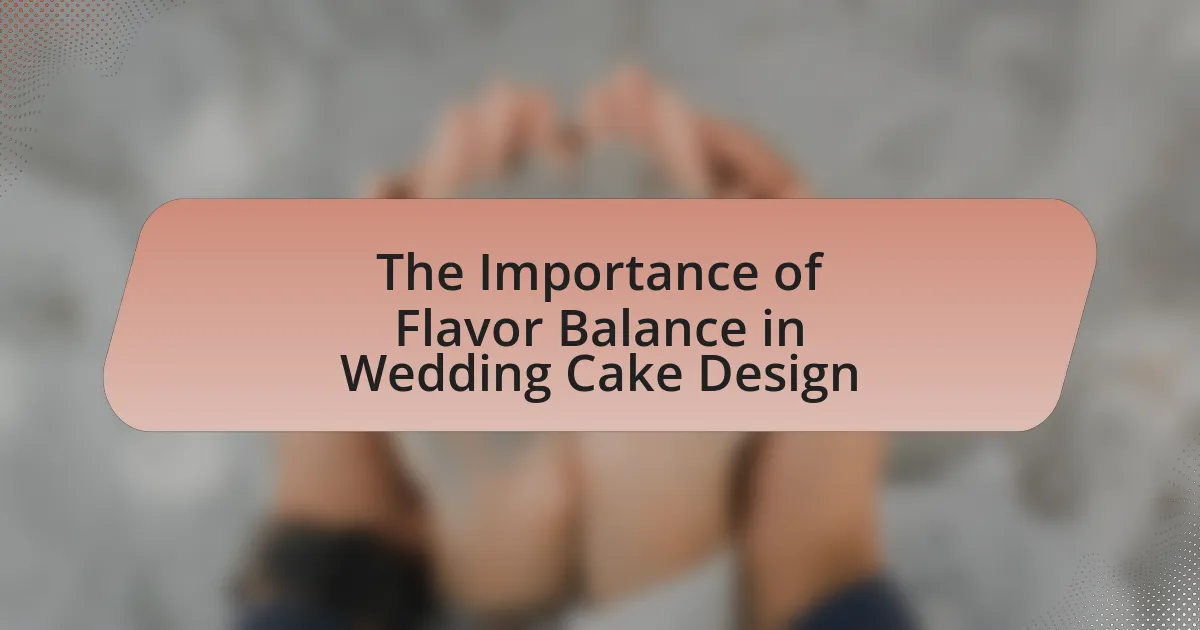The article focuses on the significance of flavor balance in wedding cake design, emphasizing its role in enhancing the overall enjoyment and appeal of the cake for a diverse range of guests. It outlines key elements that contribute to flavor balance, such as sweetness, acidity, bitterness, and saltiness, and discusses how these elements can be combined to create harmonious taste experiences. The article also addresses the impact of flavor balance on guest satisfaction, the challenges bakers face in achieving it, and current trends in flavor preferences among couples. Additionally, it provides best practices for ensuring flavor balance and tips for collaboration between couples and bakers to achieve desired outcomes in wedding cake design.

What is the Importance of Flavor Balance in Wedding Cake Design?
Flavor balance in wedding cake design is crucial because it ensures that the cake is enjoyable and appealing to a diverse range of palates. A well-balanced flavor profile enhances the overall experience of the cake, making it memorable for guests. For instance, combining sweet, tart, and savory elements can create a harmonious taste that complements the celebratory nature of weddings. Research indicates that cakes with balanced flavors are more likely to be favored by consumers, as they provide a satisfying contrast that prevents any single flavor from overwhelming the others. This balance not only elevates the cake’s taste but also contributes to its aesthetic appeal, as visually striking flavor combinations can enhance the overall presentation.
Why is flavor balance crucial in wedding cake design?
Flavor balance is crucial in wedding cake design because it ensures that the cake is enjoyable for a diverse range of palates. A well-balanced flavor profile enhances the overall experience of the cake, making it memorable for guests. For instance, combining sweet, tart, and savory elements can create a harmonious taste that appeals to different preferences, preventing any single flavor from overwhelming the others. Research indicates that cakes with balanced flavors are more likely to be rated positively by consumers, as they provide a satisfying and complex taste experience.
What are the key elements that contribute to flavor balance?
The key elements that contribute to flavor balance include sweetness, acidity, bitterness, and saltiness. Sweetness provides a base flavor that can enhance other elements, while acidity adds brightness and cuts through richness, creating contrast. Bitterness can add depth and complexity, and saltiness enhances overall flavor perception. For example, a well-balanced wedding cake often combines sweet frosting with a tangy filling, ensuring that no single flavor overwhelms the others, thus achieving a harmonious taste profile.
How does flavor balance enhance the overall cake experience?
Flavor balance enhances the overall cake experience by ensuring that no single flavor overwhelms the palate, allowing for a harmonious tasting experience. When flavors such as sweetness, acidity, and richness are well-balanced, they complement each other, creating a more enjoyable and complex flavor profile. Research indicates that balanced flavors can increase consumer satisfaction, as evidenced by a study published in the Journal of Culinary Science & Technology, which found that cakes with a well-defined flavor balance were rated higher in overall enjoyment by taste testers. This balance not only elevates the taste but also contributes to the visual and textural appeal of the cake, making it a memorable centerpiece for occasions like weddings.
What role does flavor balance play in wedding cake selection?
Flavor balance is crucial in wedding cake selection as it ensures that the cake is enjoyable for a diverse group of guests. A well-balanced flavor profile combines sweetness, acidity, and richness, preventing any single flavor from overwhelming the others. For instance, pairing a rich chocolate cake with a tangy raspberry filling creates a harmonious contrast that enhances the overall tasting experience. Studies in culinary arts emphasize that flavor balance can significantly impact guest satisfaction, making it a key consideration for couples when choosing their wedding cake.
How do couples determine their flavor preferences?
Couples determine their flavor preferences through a combination of personal taste, cultural influences, and shared experiences. They often engage in tastings, where they sample various cake flavors and fillings to identify what they both enjoy. Research indicates that couples may also consider factors such as dietary restrictions, seasonal ingredients, and the overall theme of their wedding when making flavor decisions. This collaborative process helps ensure that the chosen flavors reflect their unique relationship and enhance the overall wedding experience.
What impact does flavor balance have on guest satisfaction?
Flavor balance significantly impacts guest satisfaction by influencing the overall enjoyment of the wedding cake. When flavors are well-balanced, guests are more likely to appreciate the cake’s taste, leading to positive feedback and a memorable experience. Research indicates that a harmonious blend of sweet, savory, and acidic notes enhances palatability, which is crucial in celebratory settings like weddings. For instance, a study published in the Journal of Culinary Science & Technology found that cakes with balanced flavor profiles received higher satisfaction ratings from tasters compared to those with overwhelming sweetness or lack of complexity. This evidence underscores the importance of flavor balance in creating a cake that delights guests and contributes to their overall satisfaction at the event.

How can flavor balance be achieved in wedding cake design?
Flavor balance in wedding cake design can be achieved by carefully selecting complementary flavors and textures that enhance each other. For instance, pairing a rich chocolate cake with a light raspberry filling creates a contrast that balances sweetness and acidity. Additionally, incorporating various flavor profiles, such as citrus, vanilla, or spices, can provide depth and complexity, ensuring that no single flavor overwhelms the palate. Research indicates that a well-balanced flavor profile can enhance the overall enjoyment of desserts, as supported by studies in culinary arts that emphasize the importance of harmony in taste combinations.
What techniques can bakers use to create balanced flavors?
Bakers can create balanced flavors by using techniques such as flavor pairing, adjusting sweetness, incorporating acidity, and layering flavors. Flavor pairing involves combining ingredients that complement each other, such as chocolate with coffee or citrus with vanilla, enhancing the overall taste profile. Adjusting sweetness is crucial; bakers can balance sweetness with salt or bitter elements, ensuring that no single flavor overwhelms the others. Incorporating acidity, through ingredients like lemon juice or yogurt, can brighten flavors and provide contrast to sweetness. Layering flavors, by using different flavor components in various elements of the cake, such as the cake, frosting, and fillings, creates a harmonious blend that enhances the overall experience. These techniques are essential for achieving a well-rounded flavor profile in wedding cake design.
How do different flavor profiles complement each other?
Different flavor profiles complement each other by creating a balanced and harmonious taste experience. For instance, sweet flavors can be enhanced by the addition of acidic or bitter notes, which help to cut through the sweetness and provide depth. This principle is evident in culinary practices, such as pairing chocolate with sea salt or citrus, where the contrasting flavors elevate the overall profile. Research in flavor pairing, such as that by the food scientist Harold McGee, shows that complementary flavors can enhance the perception of taste, making dishes more enjoyable. Thus, understanding how different flavor profiles interact is crucial in wedding cake design to ensure a pleasing and memorable experience for guests.
What are some common flavor combinations for wedding cakes?
Common flavor combinations for wedding cakes include vanilla and almond, chocolate and raspberry, lemon and blueberry, and red velvet with cream cheese frosting. These combinations are popular due to their complementary tastes and textures, enhancing the overall flavor profile of the cake. For instance, vanilla and almond create a rich, aromatic base, while chocolate and raspberry offer a delightful contrast between sweet and tart. Lemon and blueberry provide a refreshing balance, and red velvet’s richness pairs well with the tanginess of cream cheese frosting. These combinations are frequently chosen for their ability to appeal to a wide range of palates, making them ideal for celebratory occasions like weddings.
What are the challenges in achieving flavor balance?
Achieving flavor balance in wedding cake design presents several challenges, primarily due to the complexity of combining various ingredients and flavor profiles. One significant challenge is the interaction between sweet, savory, and acidic elements, which can easily overpower one another if not carefully measured. For instance, a cake that is overly sweet may mask the subtleties of complementary flavors like citrus or spices, leading to a one-dimensional taste experience.
Another challenge is the variability in ingredient quality and flavor intensity, which can differ based on factors such as seasonality and sourcing. For example, fresh fruits used in fillings may have varying levels of sweetness and acidity, affecting the overall balance. Additionally, the preferences of the couple and their guests can complicate flavor decisions, as individual tastes vary widely.
Finally, achieving a harmonious texture alongside flavor balance is crucial; a cake that is too dense or dry can detract from the overall enjoyment, regardless of flavor. Therefore, careful consideration of ingredient selection, measurement, and guest preferences is essential to successfully navigate these challenges in flavor balance.
How can ingredient choices affect flavor balance?
Ingredient choices significantly affect flavor balance by determining the overall taste profile of a dish. For instance, the selection of sweeteners, acids, and fats can create harmony or discord in flavors. Sweet ingredients like sugar or honey can enhance flavors, while acidic components such as lemon juice or vinegar can provide brightness and contrast. The balance between these elements is crucial; too much sweetness can overwhelm, while excessive acidity can lead to an unpalatable dish. Research indicates that a well-balanced flavor profile often includes a combination of sweet, salty, sour, and bitter elements, which can be achieved through careful ingredient selection. For example, a study published in the “Journal of Culinary Science & Technology” highlights that the right balance of these flavors can elevate the overall sensory experience of food, making ingredient choices pivotal in achieving desired flavor balance.
What are the common mistakes to avoid in flavor balancing?
Common mistakes to avoid in flavor balancing include neglecting the interplay of flavors, overusing one dominant flavor, and failing to consider texture. Neglecting the interplay of flavors can lead to a dish that lacks depth; for example, pairing sweet and savory elements without balancing them can result in an unappealing taste. Overusing one dominant flavor, such as excessive sweetness from sugar, can overwhelm other flavors, making the cake one-dimensional. Additionally, failing to consider texture can affect the overall experience; a balance of creamy, crunchy, and moist elements enhances flavor perception. These mistakes can significantly impact the enjoyment of wedding cakes, making it essential to achieve a harmonious balance.

What are the trends in flavor balance for wedding cakes?
Current trends in flavor balance for wedding cakes emphasize a harmonious blend of complementary and contrasting flavors. Couples increasingly favor unique combinations, such as citrus paired with rich chocolate or floral notes combined with spiced elements, to create a memorable taste experience. According to a survey by The Knot, 40% of couples are opting for non-traditional flavors, indicating a shift towards personalization and creativity in cake design. This trend reflects a broader movement in the culinary world where flavor profiles are crafted to enhance the overall enjoyment of the cake, making it not just a visual centerpiece but also a delightful gastronomic highlight of the wedding celebration.
How have flavor preferences evolved in wedding cake design?
Flavor preferences in wedding cake design have evolved from traditional vanilla and chocolate to a diverse array of unique and gourmet flavors. This shift reflects changing consumer tastes and a desire for personalization in wedding celebrations. For instance, modern couples increasingly opt for flavors such as lemon, red velvet, and even unconventional choices like lavender or matcha, showcasing a trend towards more adventurous and customized cake experiences. According to a survey by The Knot in 2022, 30% of couples chose non-traditional flavors for their wedding cakes, indicating a significant departure from classic options. This evolution highlights the importance of flavor balance, as couples seek to create memorable and distinctive culinary experiences that resonate with their personal tastes and wedding themes.
What innovative flavors are gaining popularity?
Innovative flavors gaining popularity include lavender, matcha, and salted caramel. Lavender offers a floral note that enhances traditional cake flavors, while matcha introduces a unique earthy taste that appeals to health-conscious consumers. Salted caramel combines sweet and savory elements, creating a rich flavor profile that has become a favorite in modern dessert trends. These flavors reflect a shift towards more adventurous and sophisticated palate preferences in wedding cake design.
How do cultural influences shape flavor choices?
Cultural influences shape flavor choices by dictating the ingredients, preparation methods, and flavor profiles that are traditionally favored within a community. For instance, in Asian cultures, flavors such as matcha and red bean are prevalent due to their historical significance and availability, while in Western cultures, vanilla and chocolate are often preferred for their widespread acceptance and versatility. These preferences are reinforced by cultural practices, celebrations, and regional availability of ingredients, which collectively guide individuals in their flavor selections.
What are the best practices for ensuring flavor balance?
The best practices for ensuring flavor balance in wedding cake design include using a variety of complementary flavors, maintaining a balance between sweetness and acidity, and incorporating textures that enhance the overall experience. Complementary flavors, such as pairing chocolate with raspberry or vanilla with almond, create a harmonious taste profile. Balancing sweetness with acidity, for instance, by adding citrus elements to rich flavors, prevents overwhelming sweetness and enhances depth. Additionally, incorporating different textures, like creamy frostings with crunchy toppings, adds complexity and interest to each bite, contributing to a well-rounded flavor experience. These practices are supported by culinary principles that emphasize the importance of contrast and harmony in flavor profiles.
How can couples work with bakers to achieve their desired flavor balance?
Couples can work with bakers to achieve their desired flavor balance by clearly communicating their preferences and experimenting with flavor combinations. Effective communication allows couples to express their taste preferences, dietary restrictions, and any specific flavors they wish to include or avoid. Additionally, couples can participate in tastings, where they can sample various flavor profiles and provide feedback, enabling bakers to adjust recipes accordingly. This collaborative approach ensures that the final cake reflects the couple’s vision while maintaining a harmonious balance of flavors.
What tips can bakers follow to maintain flavor balance in their designs?
Bakers can maintain flavor balance in their designs by carefully selecting complementary flavors and adjusting sweetness levels. For instance, pairing rich chocolate with tart raspberry can create a harmonious contrast, while ensuring that the sweetness of the cake does not overpower the other flavors. Additionally, incorporating acidity, such as citrus zest or a splash of vinegar, can enhance flavor depth and prevent the cake from tasting overly sweet. Research indicates that a balanced flavor profile can significantly enhance the overall enjoyment of baked goods, as consumers often prefer desserts that offer a variety of taste sensations rather than a single dominant flavor.
